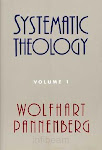The ethical element
“Faith, hope, love abide, these three; but the greatest of these is love” – to which Pelikan adds, “[yes] love, and not faith, certainly not doctrine. The church is always more than a school”. But “the church cannot be less than a school” either (p. 1).
Here one thinks of people emphasizing God’s “unknowable depth”, his “unknowability” as it were. Theology which describes God in terms of “what he is not” is called “negative” theology (apophatic theology). “God is not a person in the same way that we are,” it is said. Yes, it is true, God is much more than a person; but he is not less than a person. True negative theology is fully aware of this, as C. S. Lewis points out in a humorous analogy in his essay “Transpositions”.
Theology and ethics are inseparable (p. 1), just as “faith” and “works” are inseparable. One may add: also, just as “intellectual” and “moral” virtues are inseparable. Inseparable does not, however, mean indistinguishable: you can talk about one (theology, faith, intellectual virtues) without the other (ethics, works, moral virtues).
Much early defense of Christianity was not doctrinal, but ethical in nature. For example, one of the most widespread accusations against the “new sect” (Christianity) was the charge, “most impious and barbarous of all, that we eat human flesh” or “loaves steeped in blood”, as one early defender of Christianity, Theophilus of Antioch, explains (p. 28). The basis of this accusation was the language used by the Christians to describe Christ’s presence in the Eucharist, or Holy Communion, suggesting literal cannibalism.
Ambrose, in his dispute with Symmachus, defended Christianity on the basis of its “antiquity of morals”, not years (p. 35).
Pelikan summarizes: “Concerned as they were with ethical questions as much as with doctrinal issues, the apologists also sought to prove and defend the superiority of the Christian ethic” (p. 38).
How is the Church holy?
The church was holy because Christ was in it; therefore it was called “the spouse of Christ” or “the body of Christ”. “[T]he holiness that was the gift of the indwelling Christ also had to be an attribute of the members of the church” (p. 157).
Susanna, “a figure of the church” for Hippolytus, exhibited the freedom of sins that belonged to the true holiness of the church and of its members. Cyprian, too, saw the story of Susanna as an allegory of the church and its purity, both moral and doctrinal. Yet Cyprian and Hippolytus became involved in grave doctrinal controversies about the holiness of the church and of its members. Cyprian’s conception, which was “more profound and more complex”, became the norm for mainstream Christianity to this day.
Pelikan quotes Hamel: “For Hippolytus the church is the holiness of the saints, whose holiness is guaranteed by the unconditional purity of its members from sins of the flesh. But according to Callistus [echoing Cyprian], the church does not lose its character as ‘church catholic’ even when unworthy members remain within it.” (p. 158.)
In later years, in the name of their demand for holiness, the so-called “Donatists” felt obliged to separate themselves from the vast body of those “who called themselves catholic Christians” (Donatists wanted to claim the title “catholic” to themselves). “[F]or there could be no fellowship between the church of Christ (the Donatists) and the synagogue of Satan (the catholics)” (p. 309). But again, the guiding principle of Cyprian was ratified anew, this time reworked by Augustine to meet the challenge of the new schism.
Outside the mainstream
Another major schism (dispute within the church) was between the so-called “Montanists” and the catholic Christians. My sympathy, in a reserved fashion, for Montanism and for Tertullian was reawakened as I read Pelikan’s treatment of them. Montanism’s center was moral, not doctrinal.
“Montanism asserted that the gifts of the Spirit were absent in the church on account of its moral laxity” (p. 100–1). “This would be the quality in Montanism,” Pelikan explains, “that attracted men like Tertullian”, a former spokesman and ardent defender of catholic Christianity. “Not for its theological novelty, if any, was he drawn to it, but for its moral zeal” (p. 101).
 “Outside the Mainstream” was one of the most informative and exciting chapters in this first volume. However, I cannot remember reading whether Tertuallian’s “Montanism” was discovered during his lifetime or at a later date. Was he excommunicated or did he die a saint but be remembered a heretic? In addition, though Montanism did part company with the church in the doctrine of the Trinity (see p. 104), it was not clarified in what way, exactly, was Montanism’s view of charismata (“the gifts of the Spirit”, above) found wanting.
“Outside the Mainstream” was one of the most informative and exciting chapters in this first volume. However, I cannot remember reading whether Tertuallian’s “Montanism” was discovered during his lifetime or at a later date. Was he excommunicated or did he die a saint but be remembered a heretic? In addition, though Montanism did part company with the church in the doctrine of the Trinity (see p. 104), it was not clarified in what way, exactly, was Montanism’s view of charismata (“the gifts of the Spirit”, above) found wanting.Pelikan himself concludes: “The history of the church has never been altogether without the spontaneous gifts of the Holy Spirit, even where the authority of the apostolic norms has been most incontestable. In the experiences of monks and friars, of mystics and seers, as well as in the underground religion of many believers, the Montanist heresy has carried on a sort of unofficial existence.” (p. 108.)
Could one add to the list, “in the experience of Pentecostals and charismatic Catholics”? It would, indeed, be very intriguing to find a well-done comparative study between the history and teaching of Montanism and of the modern Charismatic movement.







No comments:
Post a Comment